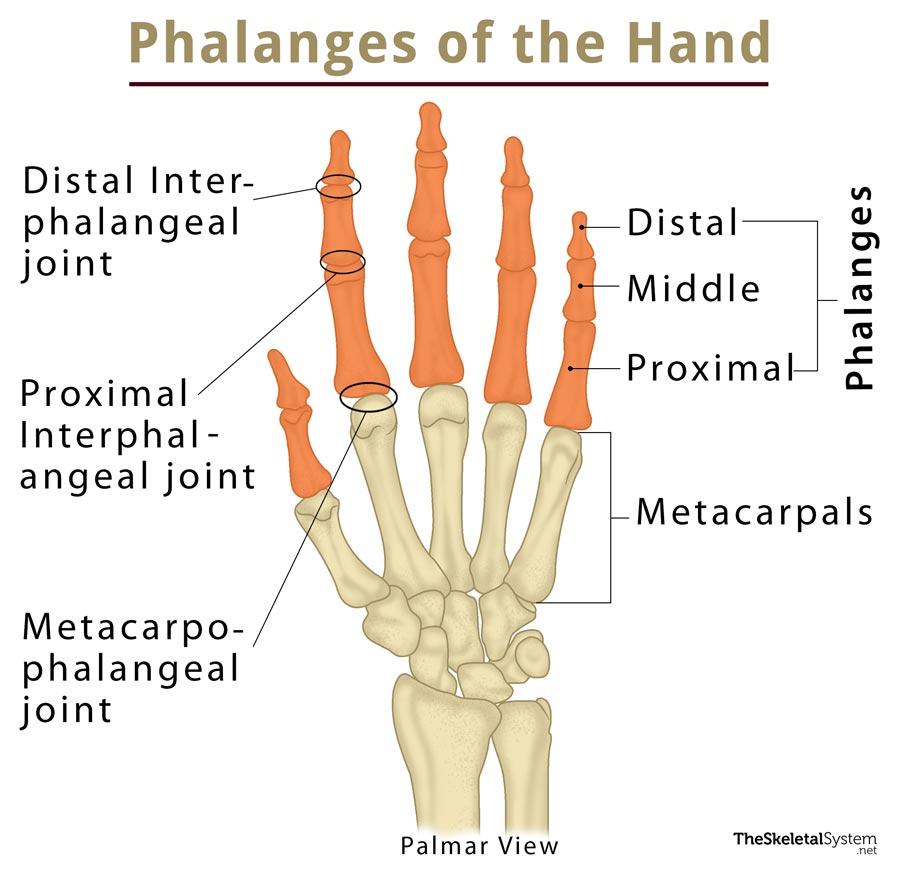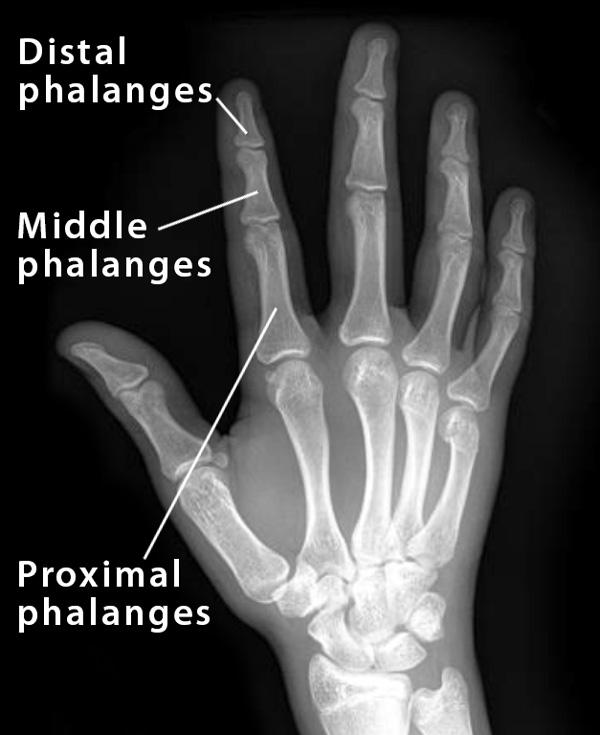Phalanges (Finger Bones)
Definition: What are the Phalanges (Phalanx) of the Finger
The tubular bones forming the fingers and thumbs in human hands are known as phalanges (singular term: phalanx) [1]. These are commonly called digital or finger bones [2].
This article deals only with the phalanges of the hands. Visit the phalanges of the feet article for information about the toe bones.
What Type of Bones are the Finger Phalanges
The phalanges of the hand are classified as long bones [3, 4].
How Many Phalanges are There in the Hand
There are three phalanges in each finger, with the thumb being the exception with just two phalanges [5]. So, there are fourteen phalanges in each hand, meaning their total number in both hands is twenty-eight.
Where are the Phalanges Located
Located within each digit, above the metacarpals, these are the terminal bones (located farthest from the center of the body) of the upper limbs in humans [6] You can feel the phalanges within your fingers and thumb, with each section of a finger having one phalanx.
Names of the Phalanges According to Location
Proximal Phalanges: Located at the proximal end, articulating with the metacarpals [6].
Middle Phalanges: Located in the middle, between the proximal phalanges and distal phalanges. The middle phalanx is not present in the human thumb, which only has a proximal and a distal phalanx [7].
Distal Phalanges: The most terminal of all the phalanges, located at the end of the digits in hand [8].
Anatomy of a Phalanx
Parts of the Bone
Like the metacarpals, each phalanx can be divided into three sections [9]:
- Base: The articular proximal end of each phalanx [1].
- Body/Shaft: The slender middle part between the head and base [8].
- Head: The distal end with or without articular surfaces (depending on the location of the phalanx) [10].
Joints
Metacarpophalangeal Joint: Articulations between the proximal end of the proximal phalanges and the rounded distal heads of their adjacent metacarpals. The metacarpophalangeal joints are examples of condyloid joints that allow the fingers a 360° motion at their base [7].
Proximal Interphalangeal Joint: Articulations between the distal end of the proximal phalanges and the proximal end of the middle phalanges. There are only 4 proximal interphalangeal joints in each hand, as the thumb lacks a middle phalanx [1].
Distal Interphalangeal Joint: Articulations between the distal end of the middle phalanges and the proximal end of the distal phalanges. This is the only interphalangeal joint within the thumb [11].
Interphalangeal joints form the knuckles of hand [12] and are a simple form of hinge joint in the human body [13].
Ligament Attachments
Both the metacarpophalangeal joints and interphalangeal joints are attached by the thick fibrous bands of the volar plates (also called the palmar ligaments). These are further united at the metacarpophalangeal joint by the deep transverse metacarpal ligament [1].
Blood Supply
The superficial palmar arch gives rise to a palmar digital artery to supply the ulnar side of the little finger. There are three common palmar digital arteries that run along the web spaces distally, dividing into proper palmar digital arteries to supply the fingers that are adjacent on either side.
The deep palmar arch gives rise to the princeps pollicis artery to supply the thumb and the radialis indicis artery to supply the radial aspect of the index finger. The dorsal metacarpal arteries have vascular connections with the dorsal, and superficial arch, as well as the common palmar digital arteries [9].
Development and Ossification
Each phalanx has two centers of ossification, the first one for the body or shaft, and the second for the base or proximal extremity. The shaft starts to ossify quite early, around the eighth week of fetal growth.
Among the bases or proximal extremities, the base of the proximal row is the first to begin ossifying between 3 and 4 years of age, with those for the middle and distal rows following a year later.
The base and shaft unite with each other when one is eighteen to twenty years old [14].
Functions of the Phalanges
The phalanges play a vital role in the movement and flexibility of digits, as well as the whole hand. These bones allow us to flex and fold the fingers and thumb to hold or pick something up, and carry on all daily activities like using a phone, typing, eating and so on. The phalanges also create insertion points for various muscles that help with the flexion of the fingers and hand [15, 16].
Common Injuries and Associated Conditions
Fracture and dislocation: These are the most common forms of injury to the phalanges, occurring due to direct stress or a blow to the hand, often during an accident or because of overuse. The knuckles are most frequently hurt. A fractured phalanx may also be associated with an injury to the ligaments, tendons, fingernails, or some other soft tissues [17].
Phalangitis: A relatively rare condition characterized by infection, and inflammation of these bones, joints, or the surrounding soft tissues. Treatment may include medications, splints, injuries, and surgeries, depending on the severity of the condition [18].
Short, underdeveloped, or hypoplastic phalanges may occur due to some birth deformity or genetic abnormality and are often associated with some multisystem disorder or other serious conditions.
References
- https://radiopaedia.org/articles/phalanges-of-the-hands
- https://depts.washington.edu/pku/PDFs2/BoneDiagram.pdf
- http://library.open.oregonstate.edu/aandp/chapter/6-2-bone-classification/
- https://www.dartmouth.edu/~humananatomy/part_1/chapter_2.html
- https://www.ncbi.nlm.nih.gov/pubmedhealth/PMHT0023111/
- https://www.kenhub.com/en/library/anatomy/the-phalanges
- http://www.innerbody.com/image/skel13.html
- http://anatomyzone.com/anatomy-feed/proximal-phalanx/
- https://prohealthsys.com/central/anatomy/grays-anatomy/index-10/index-10-2/index-10-2/phalanges_of_the_hand/
- https://www.earthslab.com/anatomy/bones-of-the-hand-carpals-metacarpals-and-phalanges/
- http://www.mccc.edu/~behrensb/documents/TheHandbig.pdf?ref=binfind.com/web
- https://www.medicinenet.com/image-collection/finger_anatomy_picture/picture.htm
- http://www.innerbody.com/image_skel07/skel31.html
- https://prohealthsys.com/central/anatomy/grays-anatomy/index-10/index-10-2/index-10-2/ossificationhand/
- https://www.rightdiagnosis.com/organ/phalanges.htm
- https://study.com/academy/lesson/phalanges-definition-function.html
- https://www.emedicinehealth.com/finger_injuries/article_em.htm
- https://www.rightdiagnosis.com/medical/phalangitis.htm



